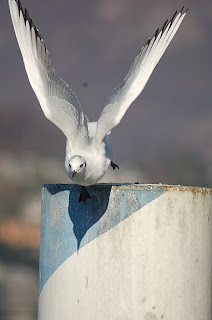TUB looking for Great Spotted Cuckoo in Extremadura (Russell F Spencer)
As I mentioned yesterday, before a flu induced haze came over me, I had a great time in Extremadura in the company of photographer extraordinaire, Russell Spencer whilst being led by the extremely knowledgable (and very nice with it) Martin Kelsey of Birding Extremadura (www.birdingextremadura.com)
Russell and I were based in Merida, the capital city of the region (which is the size of Wales). Merida has a rich Roman heritage and indeed the first place Martin took us to was The Roman Bridge that straddles the Guadiana River in the centre of the city. At 790 metres it's the longest surviving Roman bridge in the world and aside from the river, it overlooked areas of reedbed and wet woodland. Well that was what we should have been seeing. Instead, because of the excessive and unprecedented rain that had fallen recently, a lot of the habitat was under water.
Despite that, we still managed to see (and hear) Cetti's Warbler, tons of Chiffchaffs, a solo Penduline Tit, Pallid & Alpine Swifts, Barn Swallows and House Martins, Little and Cattle Egrets, Night Heron, a male Little Bittern and a couple of Purple Swamphen. The bridge is one of the best places in the region to observe Purple Swamphen.
We then nipped into the streets of Merida just as rush hour hit (if you can call 20 people a 'rush hour'!) to take a photo of me birding in the narrow streets for my next piece in BBC Wildlife Magazine. It was all a rush because I was on deadline and had to email it over pronto. So we invaded the nearby Extremadura Tourist Office and created havoc as we took over their computers to get the email over.
Next, Martin took us to a ruined Roman amphitheatre closeby were we saw plentiful Collared Dove, Serin and Greenfinch. We then drove north for 45 minutes heading for Caceres a city whose centres are dominated by Moorish and Medieval architecture. It was in the ancient part of the city that we came across the first of the many Lesser Kestrels that we saw over the ensuing days. They are absolutely lovely birds. We stood on the elevated steps of a cathedral watching them whizz past, along with seeing plentiful nesting White Stork and Spotless Starlings. In the sky above, the occasional migrating Red Kite passed over often in the slipstream of their Black cousins.
We ended the day outside a bullring in another town called Tujillo. We had come to see the nesting Lesser Kestrels that inhabited the tiled roof of the stadium. A Green Sandpiper flew overhead as Crested Larks and White Wagtails frolicked on the adjacent waste ground.
The next day saw us in the Extremadura hinterland getting a lesson in sussing the differences between Thekla and Crested Larks. We also saw Woodlark and Calandra Larks. I love Calandra Larks. They have this strange wader-like display flight on long black undersided wings. We also had several Great Spotted Cuckoo and heard our first Common Cuckoo. The region was amazing, especially when we headed into Parque Nacional de Monfrague were we witnessed masses of Griffon Vultures - and I'm talking hundreds. Plus loads of Black Vultures, a few Egyptian Vultures, a Golden Eagle, an impressive Spanish Imperial Eagle (or Iberian Eagle depending on what side of the Portuguese border you are), Short-toed Eagle, both kites and a Sparrowhawk - a relative scarcity. Did I mention the 120 or so migrating Common Cranes and the soaring Black Storks? I guess you get the picture, Extremadura was brilliant!
Anyway, I'm back at home, in the cold climes of London nursing the aftermath of flu. I certainly do lead a charmed life.


.jpg)
.jpg)




.jpg)
.JPG)






